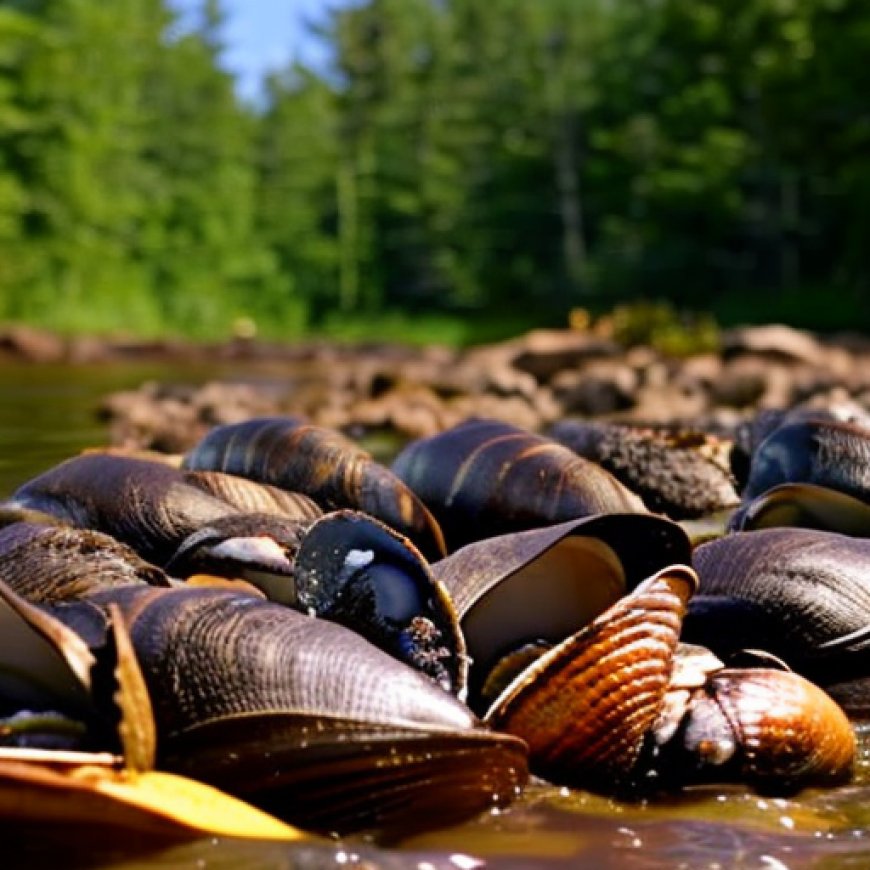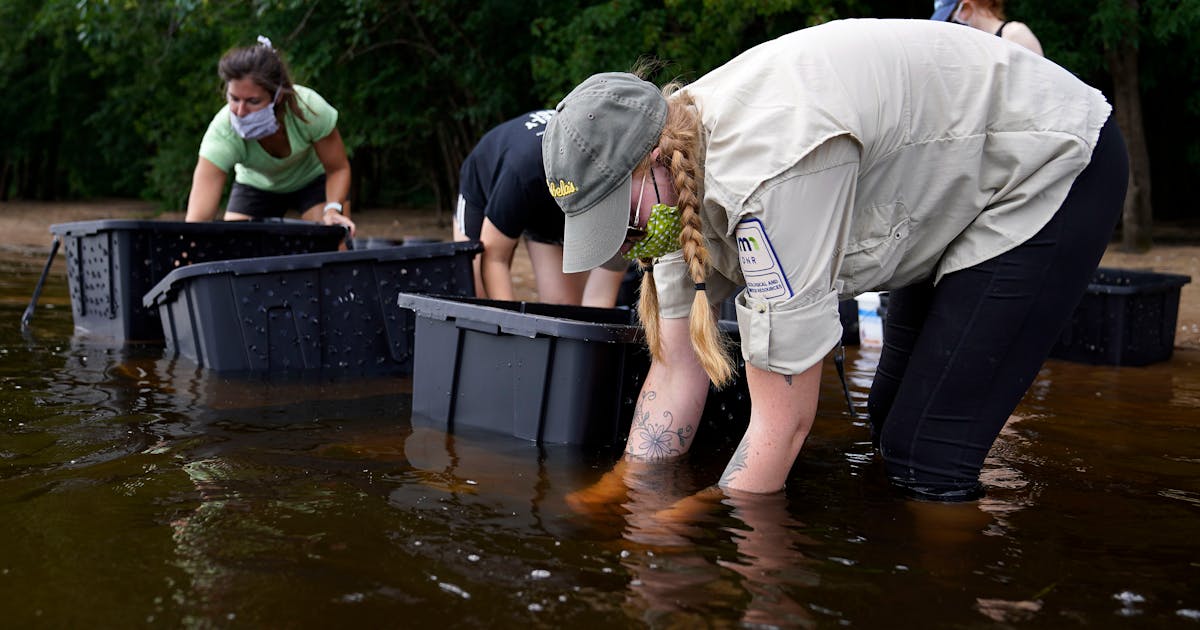Minnesota mussel decline blamed in part on the plight of the mudpuppy
Minnesota mussel decline blamed in part on the plight of the ... Star Tribune


Salamander Mussel Faces Extinction, to be Added to Endangered Species List

A one-of-a-kind river mussel that was once common throughout Minnesota and 13 other states is dying off so dramatically that it will be added to the endangered species list.
Conservation of the Salamander Mussel and the Sustainable Development Goals (SDGs)
The salamander mussel, which primarily lives under the shadows of large rocks in clear waters, is only found consistently in one place in Minnesota — a stretch of the St. Croix River south of Taylors Falls.
Two-thirds of known river mussel species in the United States are now imperiled and at risk of extinction. The salamander mussel also joins upward of 150 animal and plant species that are on the verge of disappearing in Minnesota as the world confronts a mass extinction crisis.
The Role of Mudpuppies in the Survival of Salamander Mussels
They are the only known mussel to rely on an amphibian — the mudpuppy — to survive. Mudpuppies, which are also declining, carry young mussels in their gills and bring them to the habitat they need to live.
The Importance of Salamander Mussels in the Aquatic Ecosystem
Salamander mussels typically go their entire 10 years unnoticed by humans, growing to a few inches long, quietly hunkering under the rocks where they were born and filtering the water of E. coli, algae and other bacteria and toxins, said Bernard Sietman, research scientist and malacologist for the Minnesota Department of Natural Resources.
They’re a key part of the aquatic food web, capturing what would otherwise be pollution and storing it in their bodies, Sietman said.
Threats to Salamander Mussels and Mudpuppies
Mudpuppies live under the same rocks, and hide and lay eggs in the same crevices as the mussels. When the mussels lay their eggs, they count on mudpuppies to swim or crawl into them. The eggs attach onto the gills of the mudpuppy for a short time where they grow to become juveniles. When the juveniles are big enough they harmlessly fall off the gills, where, with any luck, they’ll land under a new rock and grow to maturity.
The mussels historically lived throughout the Mississippi and Ohio rivers and their tributaries. But they’re no longer found in the upper Mississippi and have disappeared from about a third of their known populations, according to the U.S. Fish and Wildlife Service, which recently announced that it plans to add the mussels to the endangered list.
One of the reasons they’ve struggled in Minnesota is that the mudpuppy population has also been falling, Sietman said.
Causes of Decline and Conservation Efforts
The slimy salamanders that were once commonly found living in the little holes of docks or stealing fishermen’s bait — especially during winter — face the same threats as many of the state’s other declining mussel, reptile and amphibian species.
That includes water pollution from urban and industrialized agriculture runoff, dams and other barriers that cut them off from habitat and the increased frequency of strong storms that carry erosion and silt into the water.
All amphibians are prone to water pollution because they absorb toxins through their skin like sponges, said Krista Larson, nongame research biologist for the Minnesota Department of Natural Resources.
“But mudpuppies also have this extra double-whammy problem because they live under the cover of rocks and logs,” she said. “When silt gets in there it can keep them from being able to nest or get into those crevasses.”
Larson led the state’s first survey of mudpuppy populations in the early 2010s. The animals are barely hanging on in some parts of the Mississippi and Red rivers. Their main stronghold is the same stretch of the St. Croix where salamander mussels are still found, she said.
Protection and Conservation Measures
The listing will give the mussels some new federal protections. A 53-mile stretch of the St. Croix, from Taylors Falls to Hastings, will be listed as critical habitat for the species, meaning any construction or development projects that require a federal permit will need an extra layer of review. The critical habitat designation, however, does not put any new requirements on developments or actions that don’t require federal permits.
The Urgency of Conservation Efforts
Freshwater mussels, vulnerable to sediment and other water pollution, are one of the most endangered types of animals in North America. Of the 300 known species of freshwater mussels on the continent, the salamander mussel will be the 129th added to the U.S. endangered list. Another 70 species are considered imperiled.
SDGs, Targets, and Indicators
| SDGs | Targets | Indicators |
|---|---|---|
| SDG 14: Life Below Water | Target 14.1: By 2025, prevent and significantly reduce marine pollution of all kinds, in particular from land-based activities, including marine debris and nutrient pollution | – |
| SDG 15: Life on Land | Target 15.1: By 2020, ensure the conservation, restoration and sustainable use of terrestrial and inland freshwater ecosystems and their services, in particular forests, wetlands, mountains and drylands, in line with obligations under international agreements | – |
| Target 15.5: Take urgent and significant action to reduce the degradation of natural habitats, halt the loss of biodiversity and, by 2020, protect and prevent the extinction of threatened species | – | |
| SDG 6: Clean Water and Sanitation | Target 6.3: By 2030, improve water quality by reducing pollution, eliminating dumping and minimizing release of hazardous chemicals and materials, halving the proportion of untreated wastewater and substantially increasing recycling and safe reuse globally | – |
1. Which SDGs are addressed or connected to the issues highlighted in the article?
SDG 14: Life Below Water
The article discusses the decline and endangered status of the salamander mussel, a freshwater species. This is connected to SDG 14, which aims to protect and sustainably use marine and coastal ecosystems.
SDG 15: Life on Land
The article highlights the threats faced by the salamander mussel, mudpuppies, and other declining species due to water pollution, habitat loss, and increased frequency of strong storms. These issues are connected to SDG 15, which focuses on the conservation and sustainable use of terrestrial ecosystems.
2. What specific targets under those SDGs can be identified based on the article’s content?
Target 14.1: By 2025, prevent and significantly reduce marine pollution of all kinds, in particular from land-based activities, including marine debris and nutrient pollution
The article mentions water pollution from urban and industrialized agriculture runoff as one of the threats to the salamander mussel and other species. This aligns with Target 14.1 of SDG 14.
Target 15.1: By 2020, ensure the conservation, restoration and sustainable use of terrestrial and inland freshwater ecosystems and their services, in particular forests, wetlands, mountains and drylands, in line with obligations under international agreements
The article highlights the decline and endangered status of the salamander mussel, which primarily lives in freshwater ecosystems. This connects to Target 15.1 of SDG 15.
Target 15.5: Take urgent and significant action to reduce the degradation of natural habitats, halt the loss of biodiversity and, by 2020, protect and prevent the extinction of threatened species
The article discusses the decline and endangered status of the salamander mussel, mudpuppies, and other species. This aligns with Target 15.5 of SDG 15, which aims to prevent the extinction of threatened species.
3. Are there any indicators mentioned or implied in the article that can be used to measure progress towards the identified targets?
No specific indicators are mentioned or implied in the article that can be used to measure progress towards the identified targets.
4. SDGs, Targets, and Indicators
| SDGs | Targets | Indicators |
|---|---|---|
| SDG 14: Life Below Water | Target 14.1: By 2025, prevent and significantly reduce marine pollution of all kinds, in particular from land-based activities, including marine debris and nutrient pollution | – |
| SDG 15: Life on Land | Target 15.1: By 2020, ensure the conservation, restoration and sustainable use of terrestrial and inland freshwater ecosystems and their services, in particular forests, wetlands, mountains and drylands, in line with obligations under international agreements | – |
| Target 15.5: Take urgent and significant action to reduce the degradation of natural habitats, halt the loss of biodiversity and, by 2020, protect and prevent the extinction of threatened species | – |
Behold! This splendid article springs forth from the wellspring of knowledge, shaped by a wondrous proprietary AI technology that delved into a vast ocean of data, illuminating the path towards the Sustainable Development Goals. Remember that all rights are reserved by SDG Investors LLC, empowering us to champion progress together.
Source: startribune.com

Join us, as fellow seekers of change, on a transformative journey at https://sdgtalks.ai/welcome, where you can become a member and actively contribute to shaping a brighter future.







